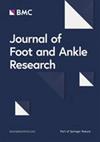踝关节骨关节炎:英国足科医生和理疗师当前治疗方法在线调查
IF 2.2
3区 医学
Q1 ORTHOPEDICS
引用次数: 0
摘要
踝关节骨关节炎(OA)疼痛患者对非手术治疗的体验不尽相同,这可能是由于临床医生缺乏对常规护理治疗的指导。因此,本研究旨在调查英国物理治疗师和足病治疗师目前治疗疼痛性踝关节骨关节炎(OA)的临床实践。治疗踝关节 OA 患者的英国物理治疗师和足病治疗师填写了一份自填式在线问卷,内容包括他们的专业和临床服务特点、诊断标准、治疗目的、首选治疗方案和治疗结果测量。数据以匿名方式收集,并存储在监委会的在线调查中。通常的护理 "定义为 "总是 "和 "经常 "的组合,"不通常的护理 "定义为 "有时"、"很少"、"从不 "和 "不适用 "的组合。物理治疗师和足病治疗师之间的回答差异在统计学上具有重要意义,我们使用 X2 检验对每种治疗方式进行了分析。统计显著性以 p < 0.05 为标准。从 2021 年 6 月 1 日至 2021 年 8 月 31 日,共收到 100 份回复;其中 2 份无效。在 98 份有效回复中,63 份来自物理治疗师,35 份来自足病治疗师。两个行业最常见的治疗目的都是减轻疼痛(87 人,占 89%)和提高生活质量(82 人,占 84%)。50 名受访者(51%)提供了 3 或 4 次治疗,53 名受访者(54%)在第一次治疗时为患者看诊 30-40 分钟。物理治疗师最常用的五种方式是患者教育(63 人,100%)、自我管理教学(58 人,92%)、生活方式调整(54 人,86%)、踝关节强化(55 人,87%)和本体感觉练习(54 人,86%)。对于足病医生而言,患者教育(35 人,100%)、踝关节强化(31 人,89%)、活动步调(28 人,80%)、生活方式调整(27 人,77%)和步态训练(27 人,77%)。这项史无前例的调查揭示了物理治疗师和足病医生目前治疗疼痛性踝关节 OA 的方法。这项研究让人们更好地了解英国目前的临床实践是如何治疗踝关节 OA 的,并为未来的临床试验提供参考,以比较目前的治疗方法和新的治疗模式。本文章由计算机程序翻译,如有差异,请以英文原文为准。
Ankle osteoarthritis: an online survey of current treatment practices of UK-based podiatrists and physiotherapists
Patients with painful ankle osteoarthritis (OA) have a mixed experience of non-surgical management which they may attribute to a lack of guidance for clinicians on usual care treatment. Therefore, the purpose of this study was to survey the current clinical practices of UK-based physiotherapists and podiatrists for the treatment of painful ankle osteoarthritis (OA). UK-based physiotherapists and podiatrists who treat patients with ankle OA completed a self-administered online questionnaire about their professional and clinical service characteristics, diagnostic criteria, treatment aims, preferred treatment options, and treatment outcome measures. Data were collected anonymously and stored on JISC online survey. ‘Usual care’ was defined as a combination of ‘Always’, and ‘Frequently’, and ‘Not usual care’ was defined as ‘Sometimes’ ‘Rarely,’ ‘Never’, and ‘not applicable’ combined. Statistically significant differences in responses between the physiotherapists and podiatrists were analysed using X2 tests for each treatment modality. Statistical significance was set at p < 0.05. Between 1st June 2021 and 31st August 2021, 100 responses were received; 2 were invalid. Of the 98 valid responses, 63 were from physiotherapists and 35 from podiatrists. The most common treatment aims in both professions were to reduce pain (n = 87, 89%) and improve quality of life (n = 82, 84%). 50 respondents (51%) offered 3 or 4 treatment sessions and 53 respondents (54%) saw patients for 30–40 min at the first treatment session. The five most common modalities used by physiotherapists were patient education (n = 63, 100%), teaching self-management (n = 58, 92%), lifestyle modification (n = 54, 86%), ankle strengthening (n = 55, 87%), and proprioception exercises (n = 54, 86%). For podiatrists, these were patient education (n = 35, 100%), ankle strengthening (n = 31, 89%), activity pacing (n = 28, 80%), lifestyle modification (n = 27, 77%), and gait training (n = 27, 77%). This first-ever survey revealed physiotherapists’ and podiatrists’ current practices to treat painful ankle OA. This study provides a better understanding of how ankle OA is treated in UK current clinical practice and can inform future clinical trials to compare current practice with new treatment modalities.
求助全文
通过发布文献求助,成功后即可免费获取论文全文。
去求助
来源期刊

Journal of Foot and Ankle Research
ORTHOPEDICS-
CiteScore
4.50
自引率
10.30%
发文量
83
审稿时长
>12 weeks
期刊介绍:
Journal of Foot and Ankle Research, the official journal of the Australian Podiatry Association and The College of Podiatry (UK), is an open access journal that encompasses all aspects of policy, organisation, delivery and clinical practice related to the assessment, diagnosis, prevention and management of foot and ankle disorders.
Journal of Foot and Ankle Research covers a wide range of clinical subject areas, including diabetology, paediatrics, sports medicine, gerontology and geriatrics, foot surgery, physical therapy, dermatology, wound management, radiology, biomechanics and bioengineering, orthotics and prosthetics, as well the broad areas of epidemiology, policy, organisation and delivery of services related to foot and ankle care.
The journal encourages submissions from all health professionals who manage lower limb conditions, including podiatrists, nurses, physical therapists and physiotherapists, orthopaedists, manual therapists, medical specialists and general medical practitioners, as well as health service researchers concerned with foot and ankle care.
The Australian Podiatry Association and the College of Podiatry (UK) have reserve funds to cover the article-processing charge for manuscripts submitted by its members. Society members can email the appropriate contact at Australian Podiatry Association or The College of Podiatry to obtain the corresponding code to enter on submission.
 求助内容:
求助内容: 应助结果提醒方式:
应助结果提醒方式:


